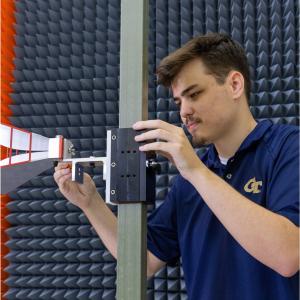
Walter Disharoon
What is your background?
I am a Ph.D. Student working in the mmWave Antennas and Arrays Lab advised by Prof. Nima Ghalichechian. I received my B.S. in Electrical Engineering from Kennesaw State University (KSU) in 2021 and recently completed my M.S. at Georgia Tech (GT) in Spring 2023. My background prior to Tech was in RF systems, RF FPGAs, and antennas. In my time at GT, I have received an ECE Freshmen Fellowship, a fellowship from Qualcomm, and the Georgia Tech Research Institute (GTRI) Graduate Student Fellowship. As part of the GTRI Fellowship, I am co-advised by GTRI faculty member Dr. Joshua Kovitz.
Undergrad experience
There were a few key experiences at KSU that built the person I am. Prior to becoming interested in RF and research I spent time as a supplemental instruction leader (SIL) for chemistry and physics. SILs are students who did well in historically difficult courses who return to help other students succeed. I spent two years being an SIL, where I gained appreciation and passion for helping students grasp new concepts. I learned many skills through being an SIL in making learning interesting and how to ignite a stronger passion in the students, which helped with my experience as a graduate teaching assistant at GT. Later, I went searching for internships, which landed me at GTRI for a Co-Op, where I had the pleasure of working in the Sensors and Electromagnetic Applications Lab as an RF engineering student assistant. I enjoyed this experience as it taught me many of the valuable skills and intuition that I still use to this day when designing antennas and other RF systems.
Why grad school?
During my time at GTRI, I noticed that a lot of the work that I found to be interesting was being led by engineers with master’s and doctoral degrees. My goal is to work on cutting edge research in a top-level research team in antenna or RF system design such as those at Qorvo, Qualcomm, Apple, etc. I chose particularly to pursue a Ph.D. to gain valuable experience working with experts in antenna design, fabrication, and testing. Furthermore, when I was an SIL, I came to enjoy the process of helping students learn new concepts and raising their interest in subjects I enjoy, so the Ph.D. is a natural progression towards being able to teach in the future if I return to academia after my future work in the industry.
Why Georgia Tech?
I had three main reasons for choosing GT: The professors, reputation, and location. In my time at GTRI, I only heard positive things about the faculty at GT particularly in the electromagnetics department, which I can only agree with after having taken classes with many of the faculty here. Second, GT has a reputation for not only electromagnetic design, but also the fabrication and testing with state-of-the-art facilities such as the IEN cleanroom. Finally, the location of GT was convenient for staying close to friends and family. I was particularly drawn to Dr. Nima’s mmWave Antennas and Arrays Lab due to their interesting work in phase change material (PCM) devices.
Research you’re working on currently and what impact do you believe it will have.
I am working on PCM enabled reconfigurable surfaces, particularly a reconfigurable reflectarray and a spatial limiter. In the reflectarray, we leverage the sharp nonlinearity of vanadium dioxide films to manipulate the electromagnetic waves polarization or direction, which could revolutionize systems for 5G and beyond communications. The spatial limiter takes advantage of nonlinearity to protect sensitive electronics from malicious or unintentional interference sources.
Tell us about anything else you wish to share like a personal hobby or talent.
I have been enjoying the pickup soccer put on by the ECE department and recently I have re-picked up rock climbing which both have been a great way to stay active and reduce stress.
